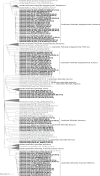Bacteriophages of Klebsiella spp., their diversity and potential therapeutic uses
- PMID: 31976857
- PMCID: PMC7431098
- DOI: 10.1099/jmm.0.001141
Bacteriophages of Klebsiella spp., their diversity and potential therapeutic uses
Abstract
Klebsiella spp. are commensals of the human microbiota, and a leading cause of opportunistic nosocomial infections. The incidence of multidrug resistant (MDR) strains of Klebsiella pneumoniae causing serious infections is increasing, and Klebsiella oxytoca is an emerging pathogen. Alternative strategies to tackle infections caused by these bacteria are required as strains become resistant to last-resort antibiotics such as colistin. Bacteriophages (phages) are viruses that can infect and kill bacteria. They and their gene products are now being considered as alternatives or adjuncts to antimicrobial therapies. Several in vitro and in vivo studies have shown the potential for lytic phages to combat MDR K. pneumoniae infections. Ready access to cheap sequencing technologies has led to a large increase in the number of genomes available for Klebsiella-infecting phages, with these phages being heterogeneous at the whole-genome level. This review summarizes our current knowledge on phages of Klebsiella spp. and highlights technological and biological issues relevant to the development of phage-based therapies targeting these bacteria.
Keywords: Klebsiella oxytoca; Klebsiella pneumoniae; antimicrobial resistance; phage therapy.
Conflict of interest statement
The authors declare that there are no conflicts of interest.
Figures

Similar articles
-
Phage therapy of antibiotic-resistant strains of Klebsiella pneumoniae, opportunities and challenges from the past to the future.Folia Microbiol (Praha). 2023 Jun;68(3):357-368. doi: 10.1007/s12223-023-01046-y. Epub 2023 Apr 10. Folia Microbiol (Praha). 2023. PMID: 37036571 Review.
-
Phage Therapy: A Promising Treatment Strategy against Infections Caused by Multidrug-resistant Klebsiella pneumoniae.Curr Pharm Des. 2025;31(13):1007-1019. doi: 10.2174/0113816128343976241117183624. Curr Pharm Des. 2025. PMID: 39757682 Review.
-
Targeted phage hunting to specific Klebsiella pneumoniae clinical isolates is an efficient antibiotic resistance and infection control strategy.Microbiol Spectr. 2024 Oct 3;12(10):e0025424. doi: 10.1128/spectrum.00254-24. Epub 2024 Aug 28. Microbiol Spectr. 2024. PMID: 39194291 Free PMC article.
-
Characterization of novel phages KPAФ1, KP149Ф1, and KP149Ф2 for lytic efficiency against clinical MDR Klebsiella pneumoniae infections.Microb Pathog. 2025 May;202:107440. doi: 10.1016/j.micpath.2025.107440. Epub 2025 Feb 28. Microb Pathog. 2025. PMID: 40024540
-
The potential use of bacteriophages as antibacterial agents against Klebsiella pneumoniae.Virol J. 2024 Aug 19;21(1):191. doi: 10.1186/s12985-024-02450-7. Virol J. 2024. PMID: 39160541 Free PMC article. Review.
Cited by
-
Malaria-Transmitting Vectors Microbiota: Overview and Interactions With Anopheles Mosquito Biology.Front Microbiol. 2022 May 20;13:891573. doi: 10.3389/fmicb.2022.891573. eCollection 2022. Front Microbiol. 2022. PMID: 35668761 Free PMC article. Review.
-
Differences in Gut Microbiota between Healthy Individuals and Patients with Perianal Abscess before and after Surgery.Mediators Inflamm. 2023 Apr 12;2023:1165916. doi: 10.1155/2023/1165916. eCollection 2023. Mediators Inflamm. 2023. PMID: 37091905 Free PMC article.
-
Phage therapy of antibiotic-resistant strains of Klebsiella pneumoniae, opportunities and challenges from the past to the future.Folia Microbiol (Praha). 2023 Jun;68(3):357-368. doi: 10.1007/s12223-023-01046-y. Epub 2023 Apr 10. Folia Microbiol (Praha). 2023. PMID: 37036571 Review.
-
Therapeutic efficacy of a K5-specific phage and depolymerase against Klebsiella pneumoniae in a mouse model of infection.Vet Res. 2024 May 7;55(1):59. doi: 10.1186/s13567-024-01311-z. Vet Res. 2024. PMID: 38715095 Free PMC article.
-
Phage Therapy: A Promising Treatment Strategy against Infections Caused by Multidrug-resistant Klebsiella pneumoniae.Curr Pharm Des. 2025;31(13):1007-1019. doi: 10.2174/0113816128343976241117183624. Curr Pharm Des. 2025. PMID: 39757682 Review.
References
-
- World Health Organization Global antimicrobial resistance surveillance system (glass) report. early implementation 2017-2018. 2018.
Publication types
MeSH terms
Grants and funding
LinkOut - more resources
Full Text Sources
Miscellaneous

